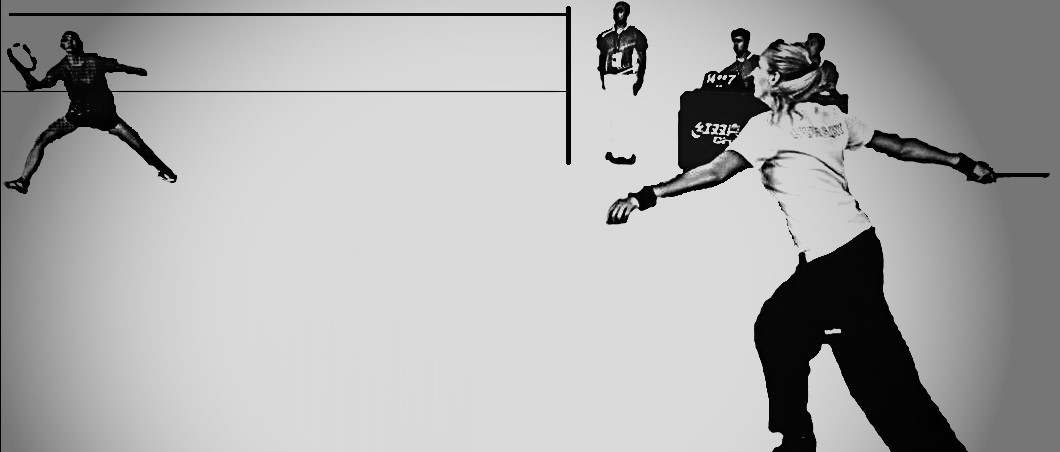Dance with Racket and Ball
Click me
[/text_box]
[/ux_banner]
ArtGame
Combine “Art” and “Game” any way you like
Click me
[/ux_slider]
Beim Bailongball gibt es zwei verschiedene Spielvarianten: Soloplay und Multiplay.
Hier erfährst Du kurz und knapp das Wichtigste über die beiden Varianten.
Bailongball im Soloplay
Beim Soloplay zählen nur Du und dein Racket. Mit fließenden Bewegungen bringst Du den Ball so in Schwung, dass er dank Zentrifugal- und Zentripetalkraft der Schwerkraft widersteht. So bleibt er immerzu am Racket ohne herunterzufallen. Dabei kannst Du deiner Kreativität freien Lauf lassen und, am besten zu passender Musik, mit Racket und Ball “tanzen”.
Es gibt drei Disziplinen, die Du beim Soloplay spielen kannst:
Standardformen: Hier geht es um festgelegte Bewegungssequenzen, die Du zur Musikansage durchführst.
Freestyle: Du hast die Freiheit. Bestimme Bewegungsabläufe und Musik selbst.
Formation: Soloplay in der Gruppe, das sind Formationen. Ihr bewegt euch synchron oder im Freestyle.
Bailongball im Multiplay
Das Multiplay lässt sich mit beliebig vielen Spielern umsetzen. Du spielst dir mit einem oder mehreren Partnern den Ball zu, ohne ihn zu schlagen oder zu schmettern. Auch hier geht es um fließende Bewegungen, denn das Annehmen und Entlassen des Balls sollten als Einheit erkennbar sein. Mit Hilfe der verschiedenen Schwungtechniken entsteht ein wunderbares Zusammenspiel zwischen Dir und deinen Spielpartnern.
Dabei hast Du die Wahl zwischen drei Disziplinen:
Freestyle: Der Ball wird ohne Begrenzung, das heißt ohne Netz, zwischen mindestens zwei Spielern hin und her gespielt. Dabei kannst Du auch Soloplay-Elemente einbringen.
Kooperativ: Bei dieser Disziplin wird auf einem TBB-Spielfeld über ein Netz gespielt. Eine Partie dauert zwei Minuten, in dieser Zeit kannst Du gemeinsam mit deinem Spielpartner Punkte sammeln.
Gegeneinander: Wie beim kooperativen Spiel wird hier über ein Netz gespielt. Der Unterschied: Die Spieler spielen gegeneinander auf Punkte und Sätze.
Compete Mini
Hier wird 1:1 gegeneinander in zwei gleich großen Feldern gespielt. Der Ball wird immer in kreisenden Bewegungen zum Gegner gespielt. Falls dieser den Ball nicht mehr annehmen kann, erhält Du einen Punkt. Mit einem Aufschwung wird der Ball ins Spiel gebracht. Das Feld darf nicht verlassen werden, solange Du den Ball führst, sonst punktet Dein Gegenüber. Verlässt der Ball in einer Abwärtsbewegung Dein Racket, landet Dein Ball im Aus oder spielst Du den Ball nicht in einer kreisenden Bewegung, punktet Dein Spielpartner auch.
Cooperate Mini
Im Team ( 2 Personen) wird miteinander in einem quadratischen Feld gespielt. In 30 Sekunden sollen jeweils möglichst viele verschiedene Schwünge gespielt werden. Pro korrekt ausgeführtem Schwung, sodass der Partner den Ball direkt aufnehmen kann, gibt es einen Punkt. Das Ganze kann auch im Turnier gespielt werden, falls zwei oder mehrere Teams gegeneinander antreten. Hier gewinnt das Team, welches alle Bewegungen am schnellsten durchführen konnte.
Du möchtest die verschiedenen Varianten und Disziplinen von Bailongball selbst ausprobieren? Wir bieten Trainings an verschiedenen Standorten an.
Zu den Trainings
the SPORT
Play solo or with / against others
There are two variations of Bailongball: Soloplay and Multiplay. Find out more about the variations in these short explanations.
Bailongball – Soloplay
Soloplay is all about you and your racket. With flowing motions you make the ball resist gravity, using centripetal force and centrifugal force. Your swinging keeps the ball on the racket, preventing it from falling to the ground. Doing so, you can let your imagination run free, “dancing” to your favorite music.
There are three disciplines you can play solo:
Standard forms: They are about predefined movements you make, guided by music.
Freestyle: Your choice – you are free to choose your moves and music.
Formation: Soloplay in a group – that is a formation. You move in sync to a standard form or Freestyle.
Bailongball – Multiplay
Play this variant with any number of people you like. You pass the ball without hitting or smashing it. Multiplay is also about flowing moves because you receive and release the ball in a swinging motion. It is a wonderful play experience.
Choose between three disciplines:
Freestyle: Play the ball without field limits or a net and with at least one partner. Include Soloplay elements if you like.
Cooperative: This discipline you play on a TBB-court over the net. Your partner and you try to collect as many points as possible within two minutes.
Competitive: As with Cooperative, you play the ball over the net. The difference: the players compete, playing against each other for points and sets.
Compete Mini
This is played 1:1 in two fields of equal dimensions. You play all balls in a circular movement to your opponents field. You score one point for every ball your opponent cannot return to your field. Every point starts with a serve swung from anywhere in the field. You may not leave the field while the ball is on your racket. If you do, your opponent scores one point. You also score one point if your opponent releases the ball in a descending trajectory, does not play the ball in a circular move or stops the ball to reverse a circular move.
Cooperate Mini
You and and your partner play together on one quadratic court. Within a 30 seconds play you try to pass the ball in as many different moves as you can. Every distinct swing of the ball to your partner counts 1 point as long as the ball does not fall to the ground. Every successful pass after your tenth distinct swing of a play counts two points. In a tournament, you can compete against other teams. The team that scores most points in three 30 seconds plays, wins the tournament.
You want to try these variants and disciplines yourself? We offer trainings at several locations.
To our trainings


 Deutsch
Deutsch
